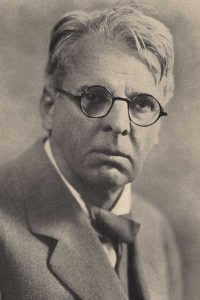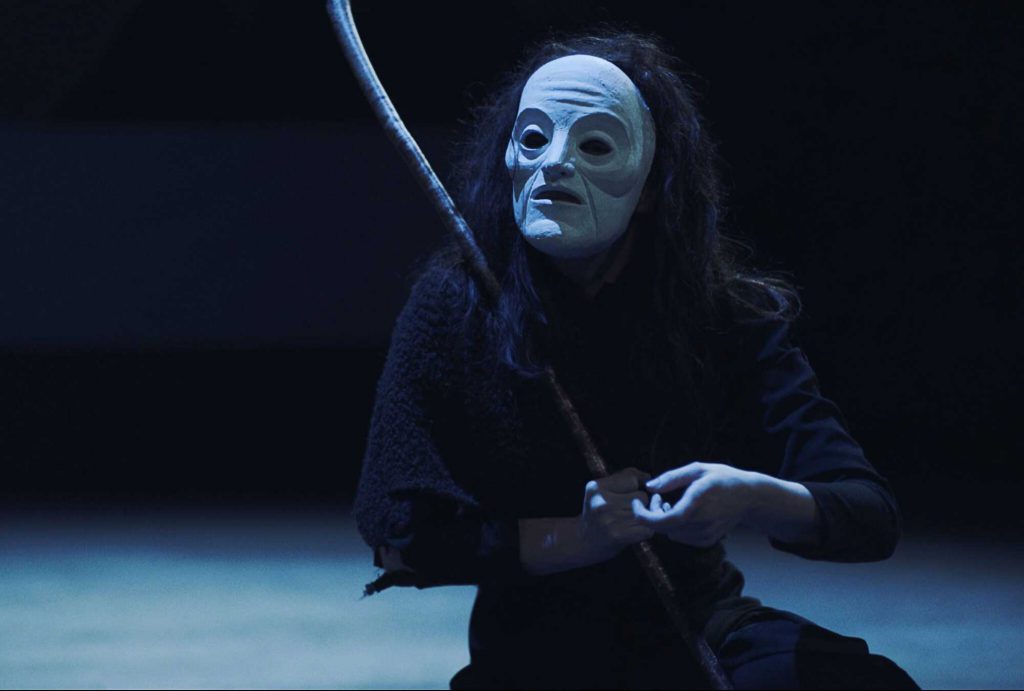At the turn of 19th and 20th century Yeats and Hearn created novel works out of their encounter with Japan. Both writers injected new life into the old traditional stories which express the soul/spirit of their respective nations. Yeats used Japanese Noh and kyogen to reinvigorate his theatrical repertoire. This, in turn, lead to a renaissance-like literary encounter between Japan and Ireland as well as more generally between the East and the West. Re-establishing this cultural exchange once again, but through a new 21st century perspective, would engender yet another theatrical renaissance marking the 60th anniversary of diplomatic relations between Ireland and Japan.
Kyogen
Japan’s classical theatrical repertoire of Noh and kyogen, developed together in the 14th century and are collectively referred to as Nohgaku. While Noh plays generally deal with serious or tragic matters, kyogen plays in contrast, are generally comical or farcical, performed most frequently between individual Noh plays.
Noh’s subjects are taken from history, mythology and classical literature while the actual plays are choreographed between song and dance. It is a highly stylized form of drama, performed on a simple, minimalist stage.
Kyogen, with laughter at its center, presents what the common people encounter in their daily lives on the same simple stage as Noh with the simplest possible stage setting. Occasionally, kyogen plays also deal with folk tales as their subject matter.
W. B. Yeats (1865-1939) and Nohgaku

Born in Ireland, this Nobel Laureate, who is regarded as one of the greatest modernist poets, became interested in theatre at the turn of the century. He and Lady Augustus Gregory founded the Irish National Theatre Society with Yeats as president with the Abbey Theatre in Dublin as their permanent home. Yeats came to know Nohgaku by way of introduction from an American poet, Ezra Pound who was compiling the manuscripts of the late Ernest Fenollosa written during his stay in Japan at the turn of the century. It fulfilled what Yeats was striving for at the time when searching for a new art form to evoke collective Irish communal identity. The first play he wrote out of this initial encounter with Noh, At the Hawk’s Well, in 1916 employs one of the greatest heroes in Irish mythology, Cuchulain. The setting too is very Irish—a sacred well whose water provided eternal life. Just like Noh, this drama touches the soul of each and every Irish person. Characters in kyogen are often anonymous folk people like servants, peasants and beggars. Therefore, they are more appropriate for Yeats’s ideal to the search for the soul or spirit of the Irish people’s common ancestry and history.
The Cat and the Moon
One kyogen in Fenollosa’s manuscript, Kikazu Zato, attracted Yeats’s attention when he wrote The Cat and the Moon. In the play’s notes, Yeats writes: “I intended my play to be what the Japanese call a ‘Kiogen,’ and to come as a relaxation between, let us say, ‘The Hawk’s Well’ and ‘The Dreaming of the Bones’.”
The two main characters in The Cat and the Moon are a blind beggar and a lame beggar. The former carries the latter on his back, just like the shite—the protagonist—and the ado—the supporting role—two recurring theatrical archetypes in traditional kyogen. The blind beggar, with his healthy legs, leads them onward while the lame beggar’s eyes help guide the way. They compliment each other’s physical insufficiencies just as in the play, Kikazu Zato. They come to St Coleman’s Well—the real well near Yeats’s residence, Thoor Ballylee—where they meet a saint, or rather hear a saint’s voice, giving them a choice between being blessed or cured of their physical handicaps. The blind man chooses to get his eyesight back while the lame man wishes to be blessed. Once regaining his eyesight, the blind man begins to engage in nasty deeds toward the man who has functioned as his “eyes” for over forty years. A healthy person’s nasty deeds towards the physically challenged is a frequent motif in a group of kyogen plays that deals with the blind, called zato mono. Zato in Japanese designates a blind person. After the cured blind man disappears from the stage, the blessed lame man begins to dance with the saint on his back, although his actual physical disability is not actually cured. Using an old folk tale in Galway, Yeats follows the tradition of kyogen’s stage setting, character development, theatrical structure, music, singing and dance to contribute something quite unique to this play. Singing and dance are used effectively in Kikazu Zato. In this play, the final dance by the blessed lame beggar culminates into a climatic cathartic moment.


Lafcadio Hearn (Yakumo Koizumi 小泉八雲, 1850-1904)

Hearn was born on Lefkada, an island in western Greece into an Irish father Charles, a military surgeon and a Greek mother, Rosa. Taken to Ireland at the age of two, he received a Catholic education in Britain and France. At the age of nineteen, he moved to the USA. After a period of living in extreme poverty, he found employment as a journalist. He first encounters with Japanese culture were through an exposition held in New Orleans, and by reading an English translation of the Kojiki, an ancient Japanese text. When Hearn arrived in Japan in April, 1890, he found employment as an English teacher at Shimane in Matsue and Kumamoto, as well as a newspaper reporter at the Kobe Chronicle, before taking up a position as lecturer of English literature at Tokyo Imperial University in 1896. He then went to teach at Waseda University. In 1896, he married Setsu Koizumi, the daughter of a Matsue samurai, and became a naturalized Japanese citizen. As a writer, he produced translations, travelogues, and retellings of classical folk tales. By doing so, he saved the ancient traditions of Japan that were about to disappear at a time of rapid Western modernization.
